Financial Reporting ACC00145: Coles' Hedge Accounting Analysis Report
VerifiedAdded on 2022/11/15
|11
|2148
|208
Report
AI Summary
This report provides a comprehensive analysis of Coles' financial reporting practices, with a specific focus on hedge accounting. It begins by defining the concept of hedging and its importance in mitigating financial risks, then delves into the qualifying criteria for hedge accounting adopted by Coles, a subsidiary of Wesfarmers. The report examines the types of hedges employed by Coles, including foreign exchange contracts, interest rate swaps, and Brent oil contracts, in accordance with AASB standards. It further evaluates the advantages and disadvantages of Coles' hedge accounting strategies, considering both fair value and cash flow hedges. Finally, the report appraises the measurement of hedging instruments and hedged items, referencing relevant accounting standards and providing insights into how Coles manages its financial risk exposure. The report utilizes figures and tables to illustrate key concepts and data, providing a clear understanding of Coles' financial reporting approach.
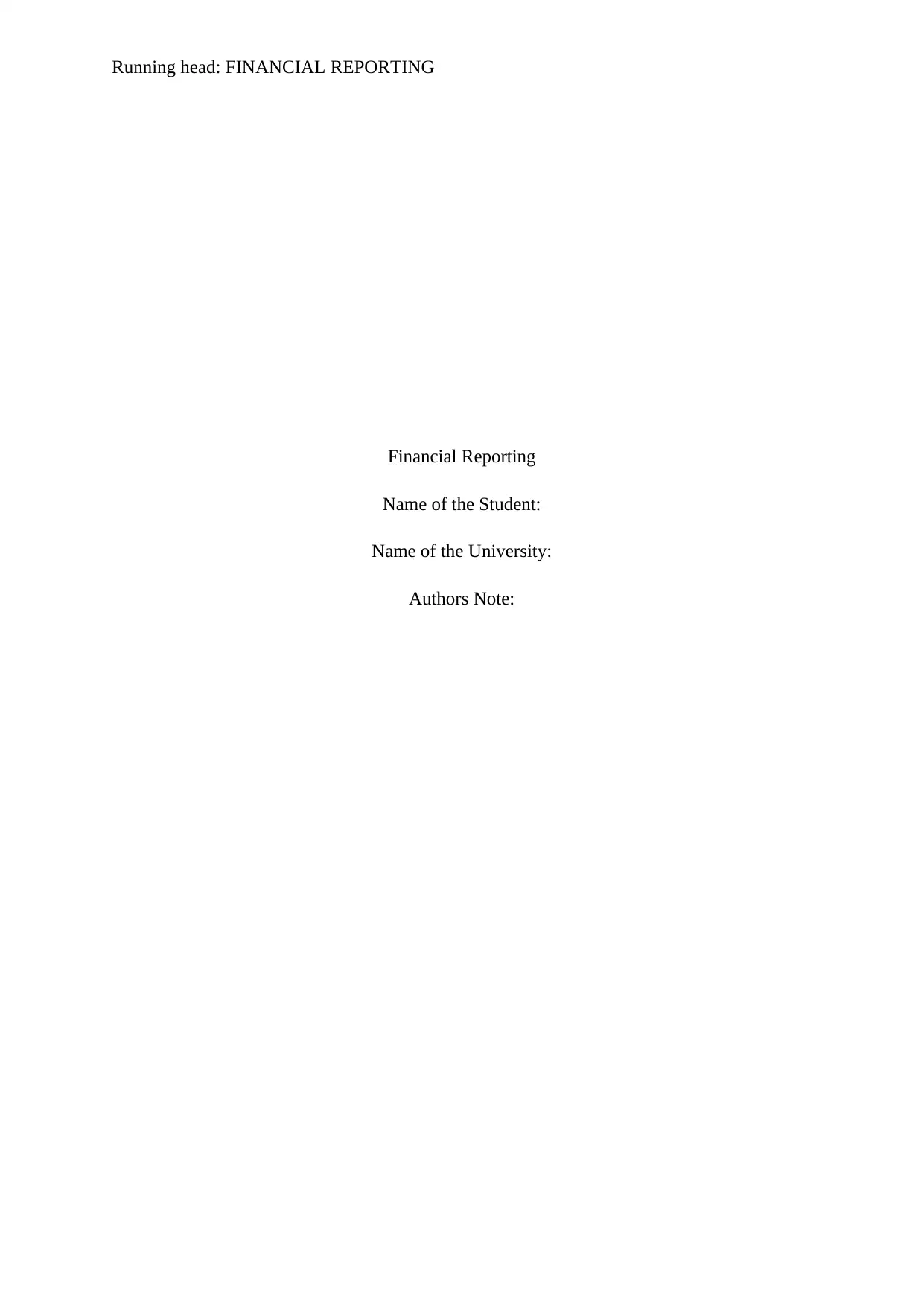
Running head: FINANCIAL REPORTING
Financial Reporting
Name of the Student:
Name of the University:
Authors Note:
Financial Reporting
Name of the Student:
Name of the University:
Authors Note:
Paraphrase This Document
Need a fresh take? Get an instant paraphrase of this document with our AI Paraphraser
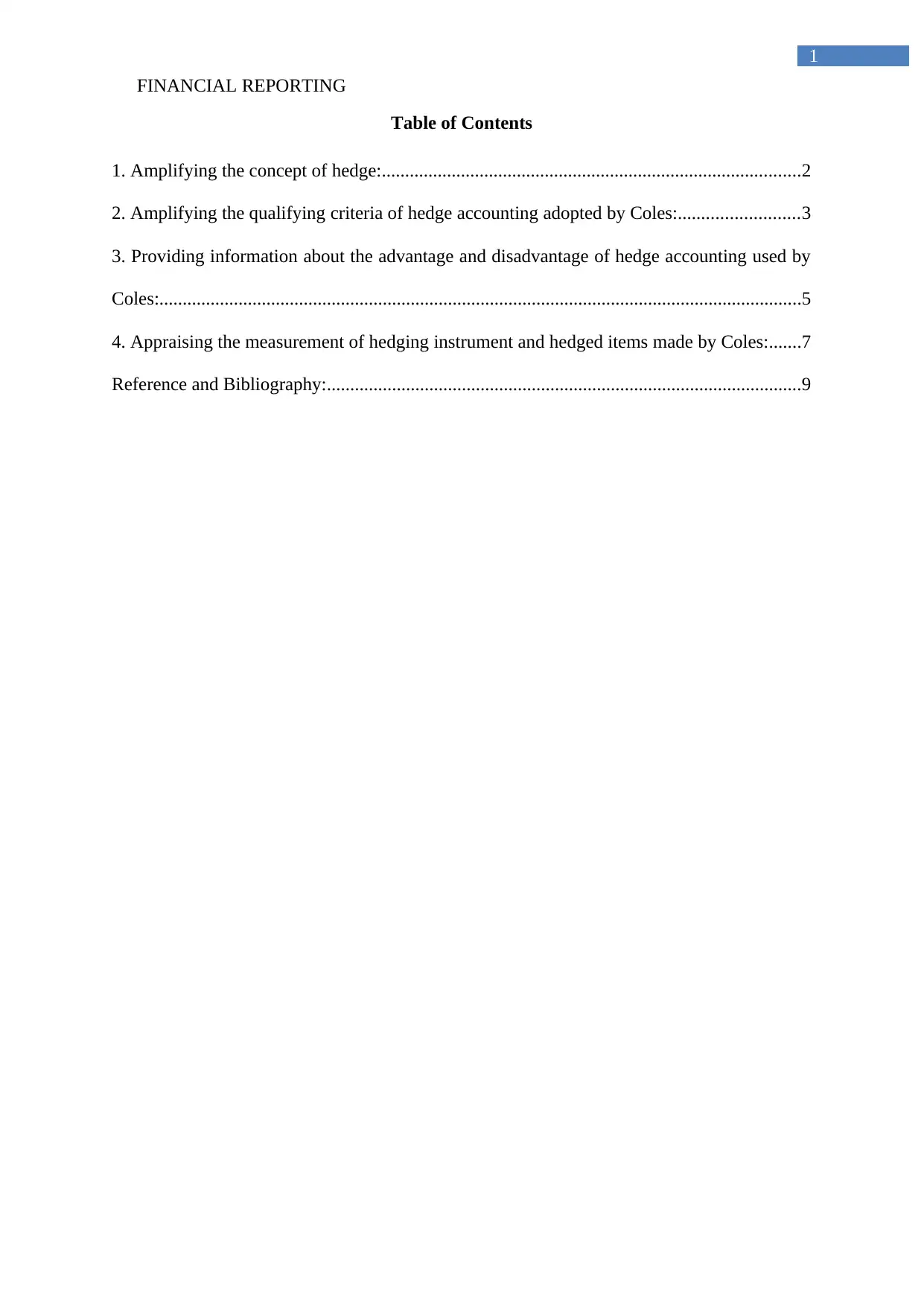
FINANCIAL REPORTING
1
Table of Contents
1. Amplifying the concept of hedge:..........................................................................................2
2. Amplifying the qualifying criteria of hedge accounting adopted by Coles:..........................3
3. Providing information about the advantage and disadvantage of hedge accounting used by
Coles:..........................................................................................................................................5
4. Appraising the measurement of hedging instrument and hedged items made by Coles:.......7
Reference and Bibliography:......................................................................................................9
1
Table of Contents
1. Amplifying the concept of hedge:..........................................................................................2
2. Amplifying the qualifying criteria of hedge accounting adopted by Coles:..........................3
3. Providing information about the advantage and disadvantage of hedge accounting used by
Coles:..........................................................................................................................................5
4. Appraising the measurement of hedging instrument and hedged items made by Coles:.......7
Reference and Bibliography:......................................................................................................9
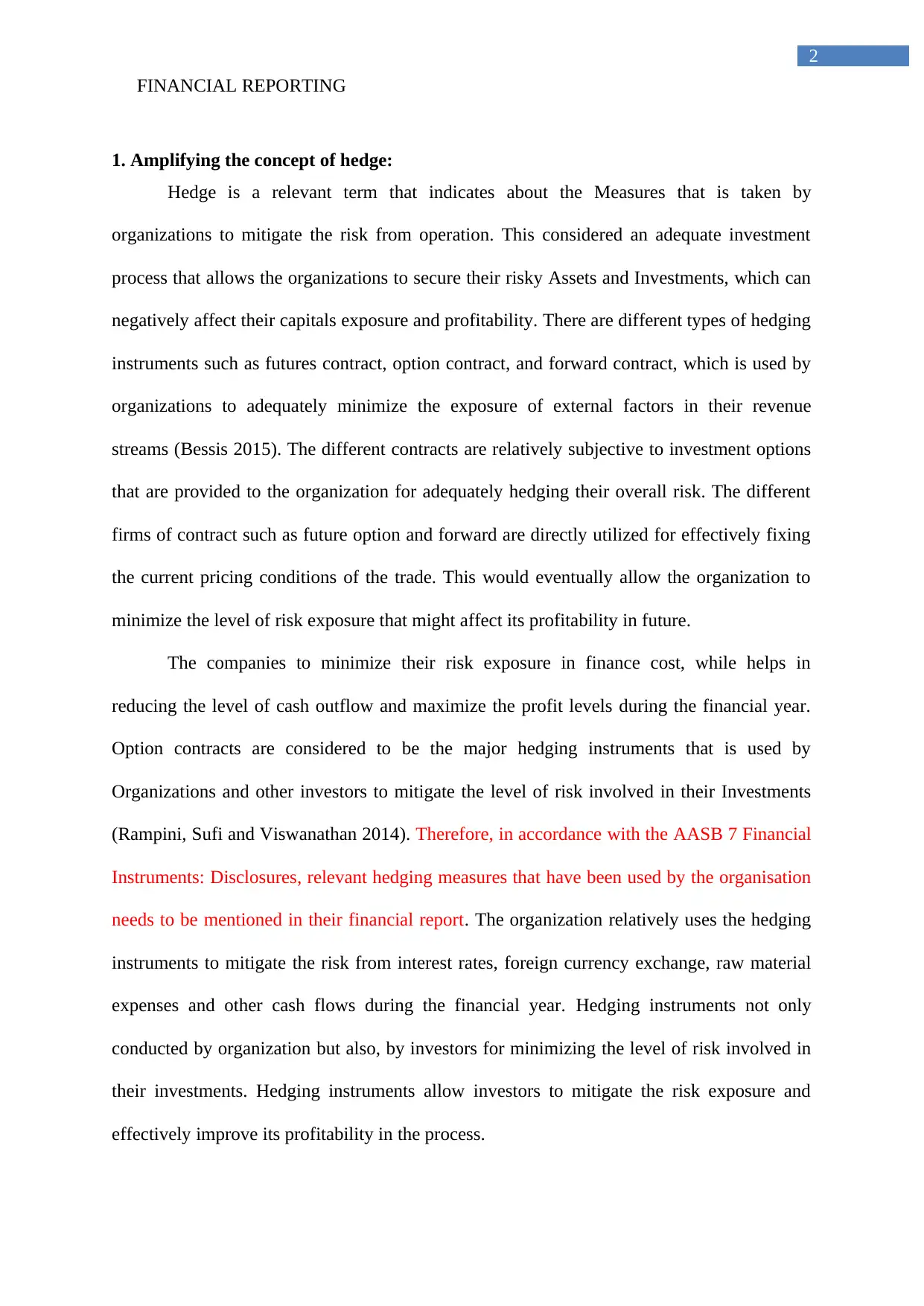
FINANCIAL REPORTING
2
1. Amplifying the concept of hedge:
Hedge is a relevant term that indicates about the Measures that is taken by
organizations to mitigate the risk from operation. This considered an adequate investment
process that allows the organizations to secure their risky Assets and Investments, which can
negatively affect their capitals exposure and profitability. There are different types of hedging
instruments such as futures contract, option contract, and forward contract, which is used by
organizations to adequately minimize the exposure of external factors in their revenue
streams (Bessis 2015). The different contracts are relatively subjective to investment options
that are provided to the organization for adequately hedging their overall risk. The different
firms of contract such as future option and forward are directly utilized for effectively fixing
the current pricing conditions of the trade. This would eventually allow the organization to
minimize the level of risk exposure that might affect its profitability in future.
The companies to minimize their risk exposure in finance cost, while helps in
reducing the level of cash outflow and maximize the profit levels during the financial year.
Option contracts are considered to be the major hedging instruments that is used by
Organizations and other investors to mitigate the level of risk involved in their Investments
(Rampini, Sufi and Viswanathan 2014). Therefore, in accordance with the AASB 7 Financial
Instruments: Disclosures, relevant hedging measures that have been used by the organisation
needs to be mentioned in their financial report. The organization relatively uses the hedging
instruments to mitigate the risk from interest rates, foreign currency exchange, raw material
expenses and other cash flows during the financial year. Hedging instruments not only
conducted by organization but also, by investors for minimizing the level of risk involved in
their investments. Hedging instruments allow investors to mitigate the risk exposure and
effectively improve its profitability in the process.
2
1. Amplifying the concept of hedge:
Hedge is a relevant term that indicates about the Measures that is taken by
organizations to mitigate the risk from operation. This considered an adequate investment
process that allows the organizations to secure their risky Assets and Investments, which can
negatively affect their capitals exposure and profitability. There are different types of hedging
instruments such as futures contract, option contract, and forward contract, which is used by
organizations to adequately minimize the exposure of external factors in their revenue
streams (Bessis 2015). The different contracts are relatively subjective to investment options
that are provided to the organization for adequately hedging their overall risk. The different
firms of contract such as future option and forward are directly utilized for effectively fixing
the current pricing conditions of the trade. This would eventually allow the organization to
minimize the level of risk exposure that might affect its profitability in future.
The companies to minimize their risk exposure in finance cost, while helps in
reducing the level of cash outflow and maximize the profit levels during the financial year.
Option contracts are considered to be the major hedging instruments that is used by
Organizations and other investors to mitigate the level of risk involved in their Investments
(Rampini, Sufi and Viswanathan 2014). Therefore, in accordance with the AASB 7 Financial
Instruments: Disclosures, relevant hedging measures that have been used by the organisation
needs to be mentioned in their financial report. The organization relatively uses the hedging
instruments to mitigate the risk from interest rates, foreign currency exchange, raw material
expenses and other cash flows during the financial year. Hedging instruments not only
conducted by organization but also, by investors for minimizing the level of risk involved in
their investments. Hedging instruments allow investors to mitigate the risk exposure and
effectively improve its profitability in the process.
⊘ This is a preview!⊘
Do you want full access?
Subscribe today to unlock all pages.

Trusted by 1+ million students worldwide
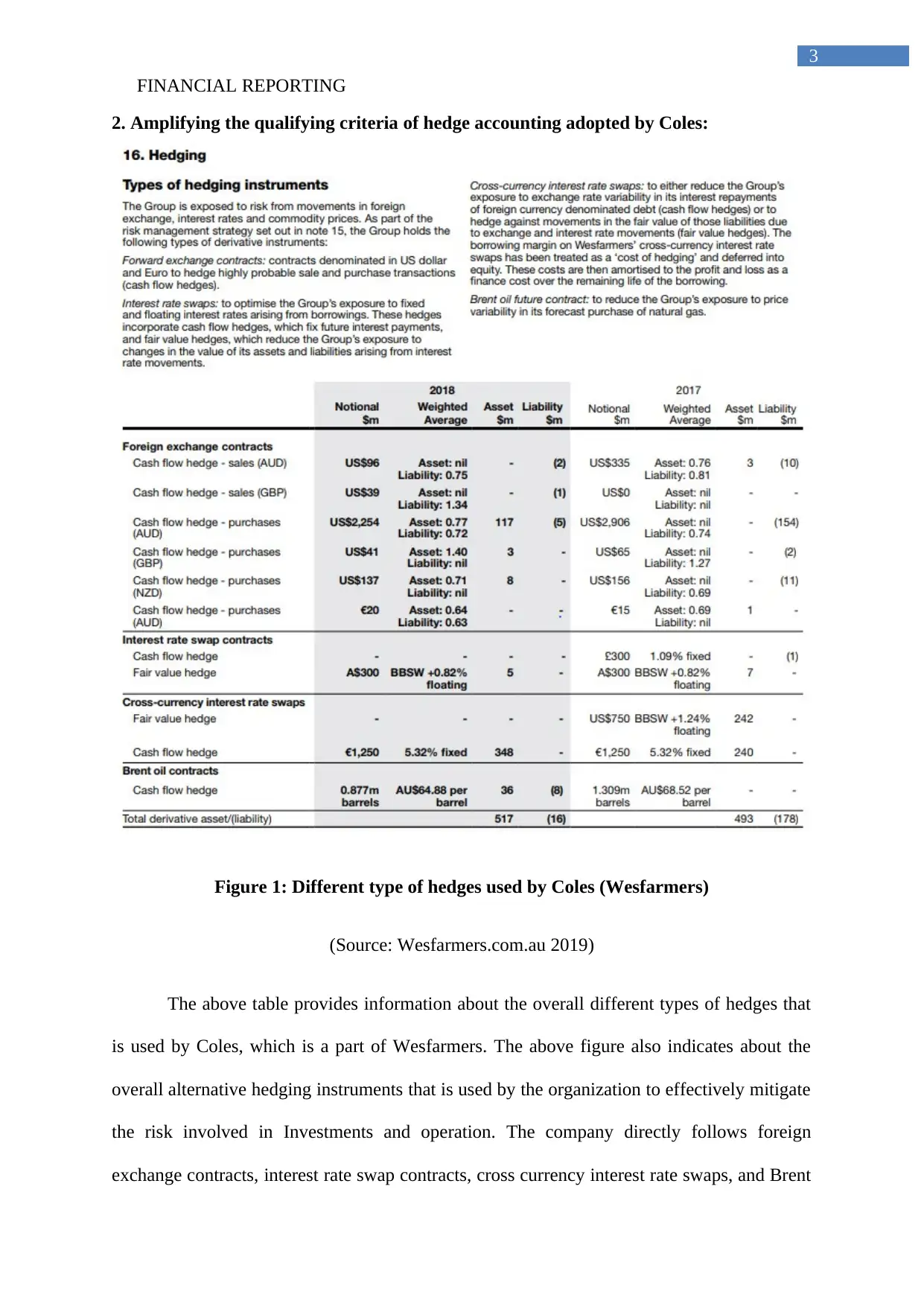
FINANCIAL REPORTING
3
2. Amplifying the qualifying criteria of hedge accounting adopted by Coles:
Figure 1: Different type of hedges used by Coles (Wesfarmers)
(Source: Wesfarmers.com.au 2019)
The above table provides information about the overall different types of hedges that
is used by Coles, which is a part of Wesfarmers. The above figure also indicates about the
overall alternative hedging instruments that is used by the organization to effectively mitigate
the risk involved in Investments and operation. The company directly follows foreign
exchange contracts, interest rate swap contracts, cross currency interest rate swaps, and Brent
3
2. Amplifying the qualifying criteria of hedge accounting adopted by Coles:
Figure 1: Different type of hedges used by Coles (Wesfarmers)
(Source: Wesfarmers.com.au 2019)
The above table provides information about the overall different types of hedges that
is used by Coles, which is a part of Wesfarmers. The above figure also indicates about the
overall alternative hedging instruments that is used by the organization to effectively mitigate
the risk involved in Investments and operation. The company directly follows foreign
exchange contracts, interest rate swap contracts, cross currency interest rate swaps, and Brent
Paraphrase This Document
Need a fresh take? Get an instant paraphrase of this document with our AI Paraphraser
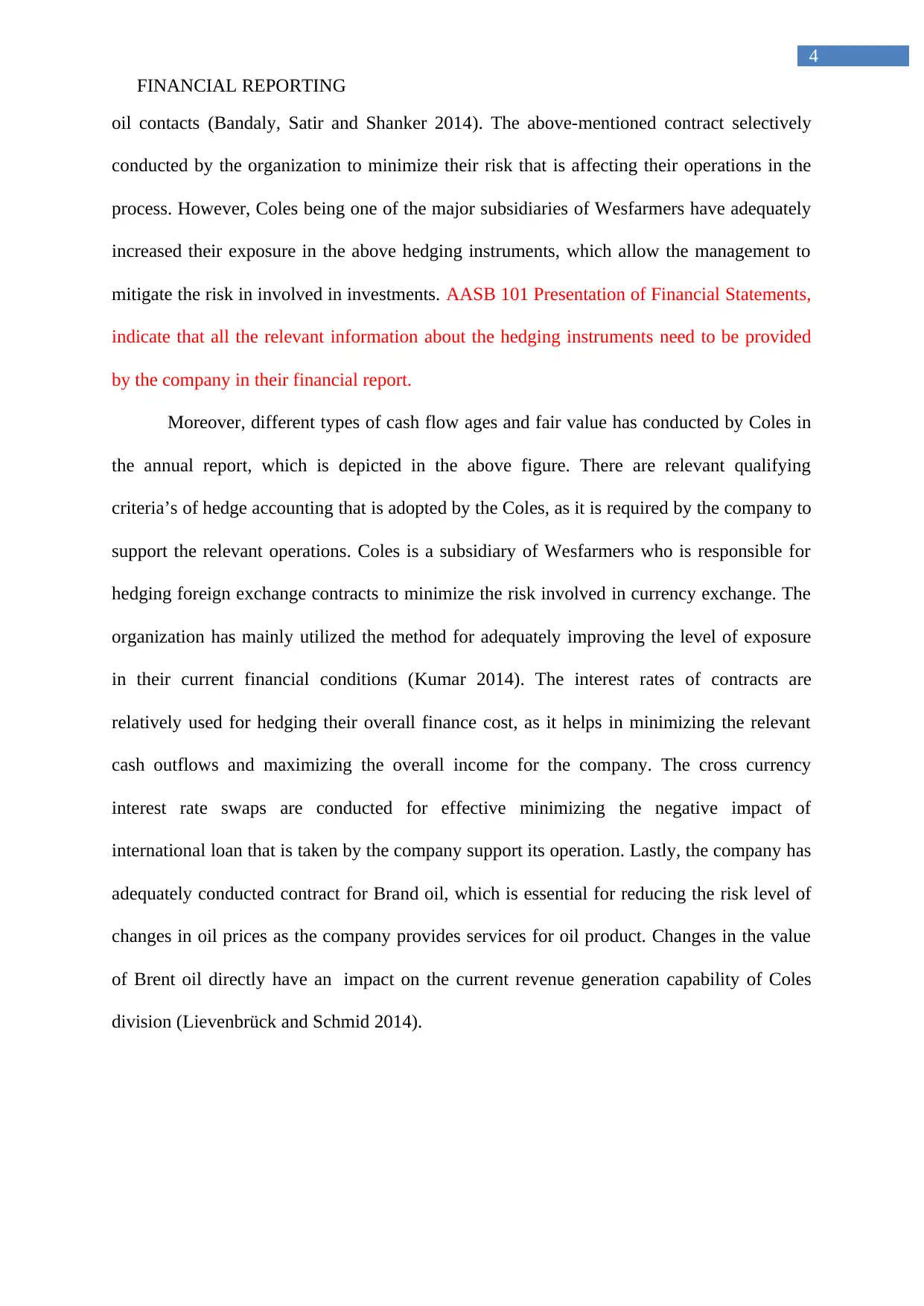
FINANCIAL REPORTING
4
oil contacts (Bandaly, Satir and Shanker 2014). The above-mentioned contract selectively
conducted by the organization to minimize their risk that is affecting their operations in the
process. However, Coles being one of the major subsidiaries of Wesfarmers have adequately
increased their exposure in the above hedging instruments, which allow the management to
mitigate the risk in involved in investments. AASB 101 Presentation of Financial Statements,
indicate that all the relevant information about the hedging instruments need to be provided
by the company in their financial report.
Moreover, different types of cash flow ages and fair value has conducted by Coles in
the annual report, which is depicted in the above figure. There are relevant qualifying
criteria’s of hedge accounting that is adopted by the Coles, as it is required by the company to
support the relevant operations. Coles is a subsidiary of Wesfarmers who is responsible for
hedging foreign exchange contracts to minimize the risk involved in currency exchange. The
organization has mainly utilized the method for adequately improving the level of exposure
in their current financial conditions (Kumar 2014). The interest rates of contracts are
relatively used for hedging their overall finance cost, as it helps in minimizing the relevant
cash outflows and maximizing the overall income for the company. The cross currency
interest rate swaps are conducted for effective minimizing the negative impact of
international loan that is taken by the company support its operation. Lastly, the company has
adequately conducted contract for Brand oil, which is essential for reducing the risk level of
changes in oil prices as the company provides services for oil product. Changes in the value
of Brent oil directly have an impact on the current revenue generation capability of Coles
division (Lievenbrück and Schmid 2014).
4
oil contacts (Bandaly, Satir and Shanker 2014). The above-mentioned contract selectively
conducted by the organization to minimize their risk that is affecting their operations in the
process. However, Coles being one of the major subsidiaries of Wesfarmers have adequately
increased their exposure in the above hedging instruments, which allow the management to
mitigate the risk in involved in investments. AASB 101 Presentation of Financial Statements,
indicate that all the relevant information about the hedging instruments need to be provided
by the company in their financial report.
Moreover, different types of cash flow ages and fair value has conducted by Coles in
the annual report, which is depicted in the above figure. There are relevant qualifying
criteria’s of hedge accounting that is adopted by the Coles, as it is required by the company to
support the relevant operations. Coles is a subsidiary of Wesfarmers who is responsible for
hedging foreign exchange contracts to minimize the risk involved in currency exchange. The
organization has mainly utilized the method for adequately improving the level of exposure
in their current financial conditions (Kumar 2014). The interest rates of contracts are
relatively used for hedging their overall finance cost, as it helps in minimizing the relevant
cash outflows and maximizing the overall income for the company. The cross currency
interest rate swaps are conducted for effective minimizing the negative impact of
international loan that is taken by the company support its operation. Lastly, the company has
adequately conducted contract for Brand oil, which is essential for reducing the risk level of
changes in oil prices as the company provides services for oil product. Changes in the value
of Brent oil directly have an impact on the current revenue generation capability of Coles
division (Lievenbrück and Schmid 2014).
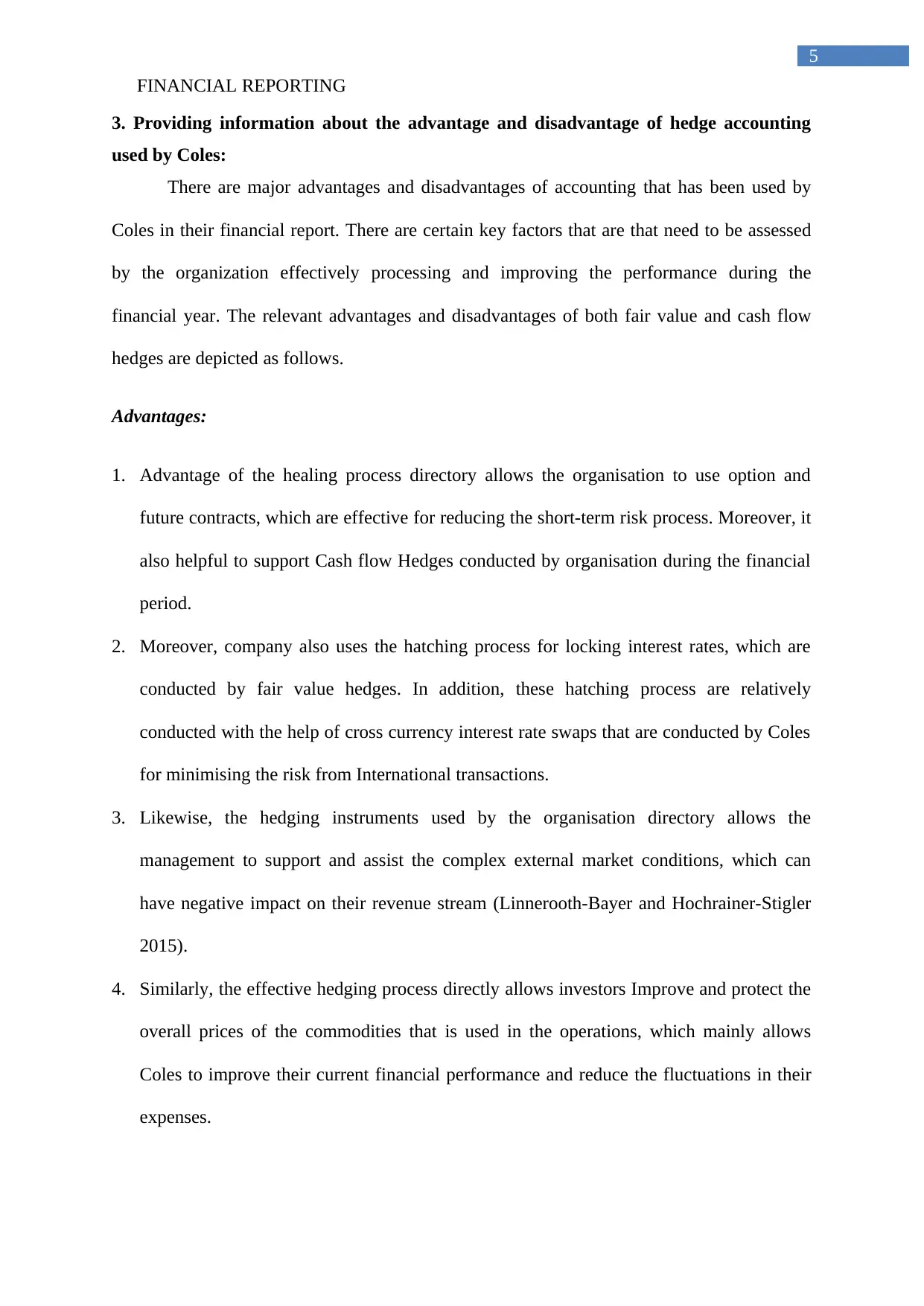
FINANCIAL REPORTING
5
3. Providing information about the advantage and disadvantage of hedge accounting
used by Coles:
There are major advantages and disadvantages of accounting that has been used by
Coles in their financial report. There are certain key factors that are that need to be assessed
by the organization effectively processing and improving the performance during the
financial year. The relevant advantages and disadvantages of both fair value and cash flow
hedges are depicted as follows.
Advantages:
1. Advantage of the healing process directory allows the organisation to use option and
future contracts, which are effective for reducing the short-term risk process. Moreover, it
also helpful to support Cash flow Hedges conducted by organisation during the financial
period.
2. Moreover, company also uses the hatching process for locking interest rates, which are
conducted by fair value hedges. In addition, these hatching process are relatively
conducted with the help of cross currency interest rate swaps that are conducted by Coles
for minimising the risk from International transactions.
3. Likewise, the hedging instruments used by the organisation directory allows the
management to support and assist the complex external market conditions, which can
have negative impact on their revenue stream (Linnerooth-Bayer and Hochrainer-Stigler
2015).
4. Similarly, the effective hedging process directly allows investors Improve and protect the
overall prices of the commodities that is used in the operations, which mainly allows
Coles to improve their current financial performance and reduce the fluctuations in their
expenses.
5
3. Providing information about the advantage and disadvantage of hedge accounting
used by Coles:
There are major advantages and disadvantages of accounting that has been used by
Coles in their financial report. There are certain key factors that are that need to be assessed
by the organization effectively processing and improving the performance during the
financial year. The relevant advantages and disadvantages of both fair value and cash flow
hedges are depicted as follows.
Advantages:
1. Advantage of the healing process directory allows the organisation to use option and
future contracts, which are effective for reducing the short-term risk process. Moreover, it
also helpful to support Cash flow Hedges conducted by organisation during the financial
period.
2. Moreover, company also uses the hatching process for locking interest rates, which are
conducted by fair value hedges. In addition, these hatching process are relatively
conducted with the help of cross currency interest rate swaps that are conducted by Coles
for minimising the risk from International transactions.
3. Likewise, the hedging instruments used by the organisation directory allows the
management to support and assist the complex external market conditions, which can
have negative impact on their revenue stream (Linnerooth-Bayer and Hochrainer-Stigler
2015).
4. Similarly, the effective hedging process directly allows investors Improve and protect the
overall prices of the commodities that is used in the operations, which mainly allows
Coles to improve their current financial performance and reduce the fluctuations in their
expenses.
⊘ This is a preview!⊘
Do you want full access?
Subscribe today to unlock all pages.

Trusted by 1+ million students worldwide
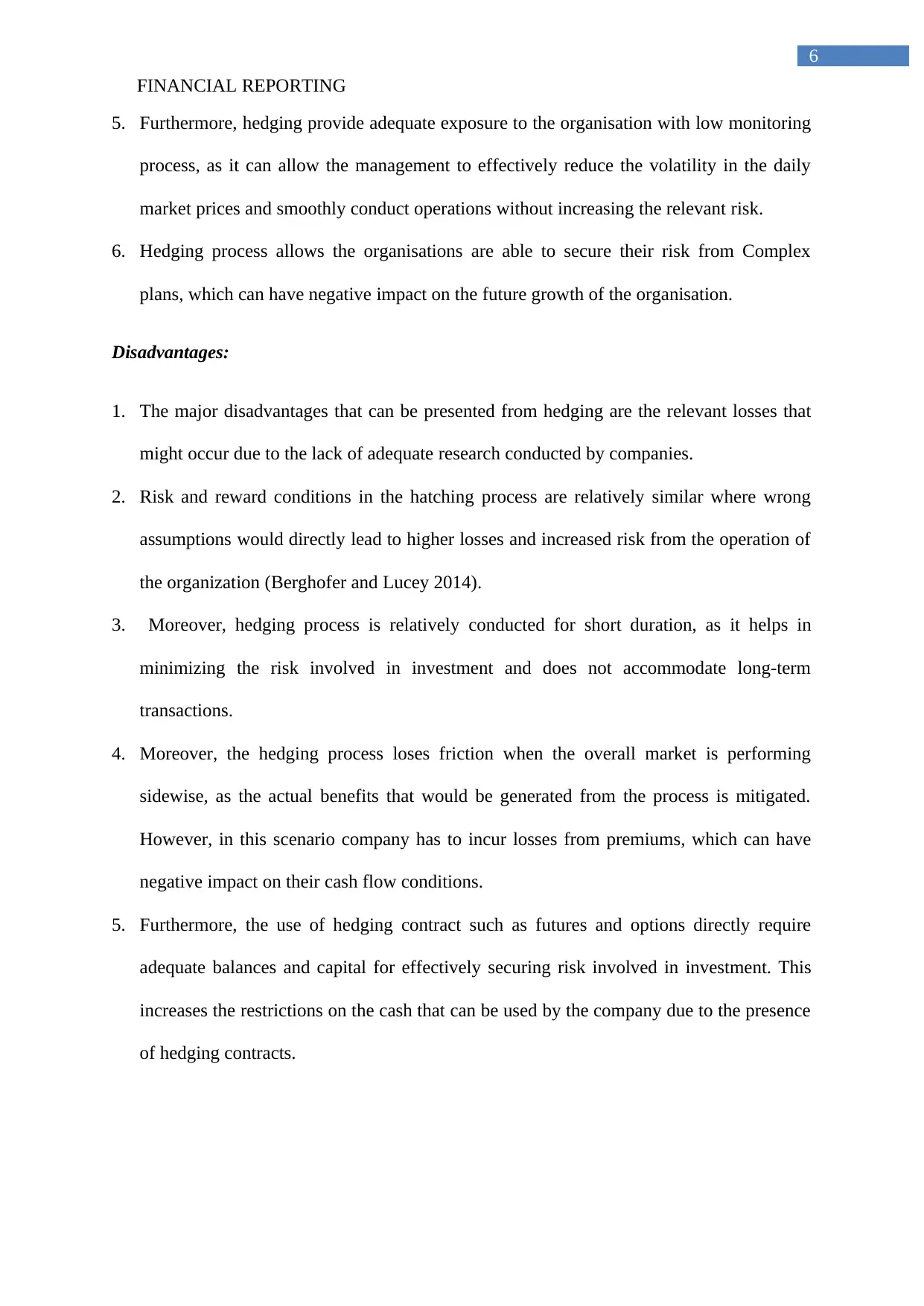
FINANCIAL REPORTING
6
5. Furthermore, hedging provide adequate exposure to the organisation with low monitoring
process, as it can allow the management to effectively reduce the volatility in the daily
market prices and smoothly conduct operations without increasing the relevant risk.
6. Hedging process allows the organisations are able to secure their risk from Complex
plans, which can have negative impact on the future growth of the organisation.
Disadvantages:
1. The major disadvantages that can be presented from hedging are the relevant losses that
might occur due to the lack of adequate research conducted by companies.
2. Risk and reward conditions in the hatching process are relatively similar where wrong
assumptions would directly lead to higher losses and increased risk from the operation of
the organization (Berghofer and Lucey 2014).
3. Moreover, hedging process is relatively conducted for short duration, as it helps in
minimizing the risk involved in investment and does not accommodate long-term
transactions.
4. Moreover, the hedging process loses friction when the overall market is performing
sidewise, as the actual benefits that would be generated from the process is mitigated.
However, in this scenario company has to incur losses from premiums, which can have
negative impact on their cash flow conditions.
5. Furthermore, the use of hedging contract such as futures and options directly require
adequate balances and capital for effectively securing risk involved in investment. This
increases the restrictions on the cash that can be used by the company due to the presence
of hedging contracts.
6
5. Furthermore, hedging provide adequate exposure to the organisation with low monitoring
process, as it can allow the management to effectively reduce the volatility in the daily
market prices and smoothly conduct operations without increasing the relevant risk.
6. Hedging process allows the organisations are able to secure their risk from Complex
plans, which can have negative impact on the future growth of the organisation.
Disadvantages:
1. The major disadvantages that can be presented from hedging are the relevant losses that
might occur due to the lack of adequate research conducted by companies.
2. Risk and reward conditions in the hatching process are relatively similar where wrong
assumptions would directly lead to higher losses and increased risk from the operation of
the organization (Berghofer and Lucey 2014).
3. Moreover, hedging process is relatively conducted for short duration, as it helps in
minimizing the risk involved in investment and does not accommodate long-term
transactions.
4. Moreover, the hedging process loses friction when the overall market is performing
sidewise, as the actual benefits that would be generated from the process is mitigated.
However, in this scenario company has to incur losses from premiums, which can have
negative impact on their cash flow conditions.
5. Furthermore, the use of hedging contract such as futures and options directly require
adequate balances and capital for effectively securing risk involved in investment. This
increases the restrictions on the cash that can be used by the company due to the presence
of hedging contracts.
Paraphrase This Document
Need a fresh take? Get an instant paraphrase of this document with our AI Paraphraser
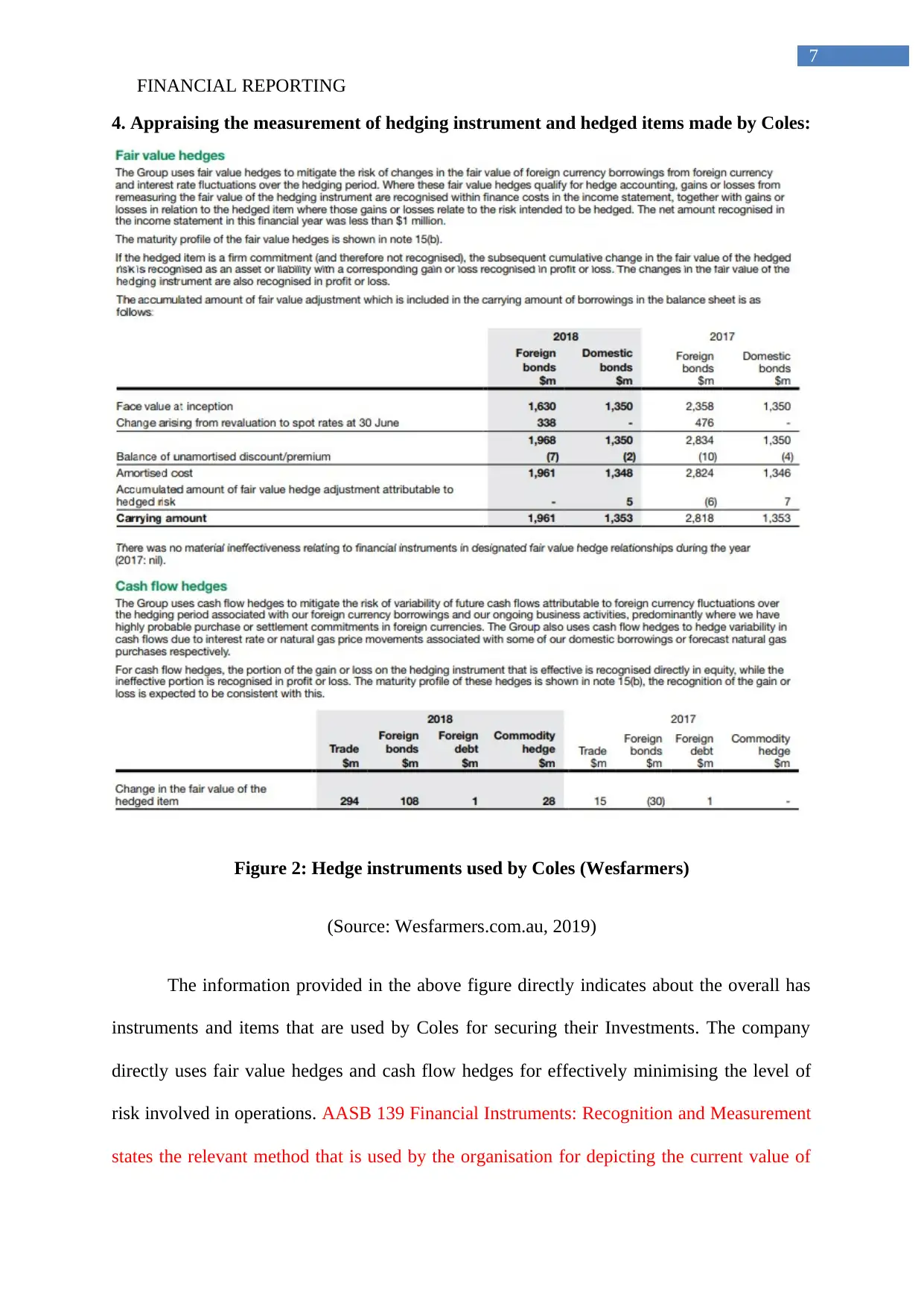
FINANCIAL REPORTING
7
4. Appraising the measurement of hedging instrument and hedged items made by Coles:
Figure 2: Hedge instruments used by Coles (Wesfarmers)
(Source: Wesfarmers.com.au, 2019)
The information provided in the above figure directly indicates about the overall has
instruments and items that are used by Coles for securing their Investments. The company
directly uses fair value hedges and cash flow hedges for effectively minimising the level of
risk involved in operations. AASB 139 Financial Instruments: Recognition and Measurement
states the relevant method that is used by the organisation for depicting the current value of
7
4. Appraising the measurement of hedging instrument and hedged items made by Coles:
Figure 2: Hedge instruments used by Coles (Wesfarmers)
(Source: Wesfarmers.com.au, 2019)
The information provided in the above figure directly indicates about the overall has
instruments and items that are used by Coles for securing their Investments. The company
directly uses fair value hedges and cash flow hedges for effectively minimising the level of
risk involved in operations. AASB 139 Financial Instruments: Recognition and Measurement
states the relevant method that is used by the organisation for depicting the current value of
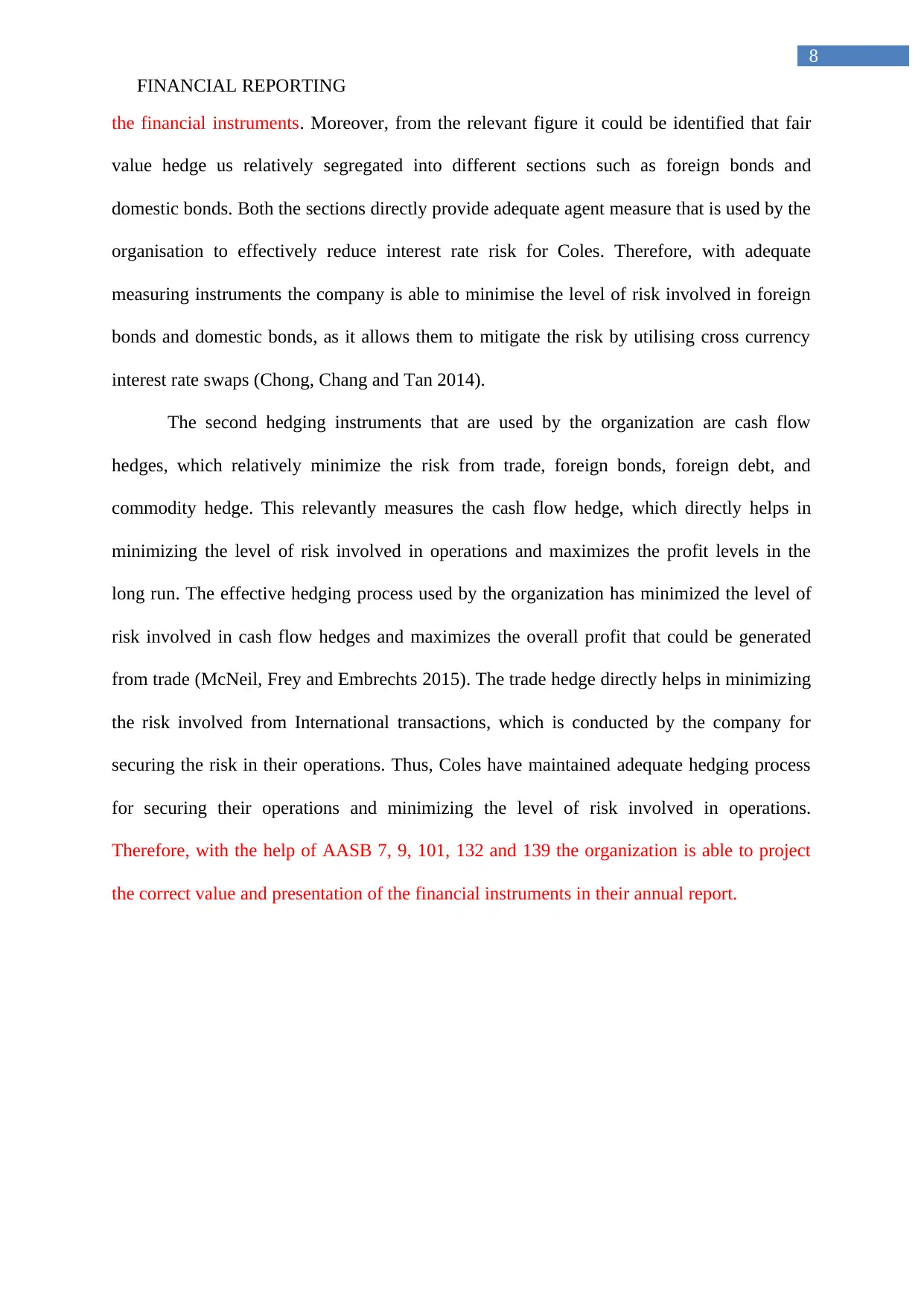
FINANCIAL REPORTING
8
the financial instruments. Moreover, from the relevant figure it could be identified that fair
value hedge us relatively segregated into different sections such as foreign bonds and
domestic bonds. Both the sections directly provide adequate agent measure that is used by the
organisation to effectively reduce interest rate risk for Coles. Therefore, with adequate
measuring instruments the company is able to minimise the level of risk involved in foreign
bonds and domestic bonds, as it allows them to mitigate the risk by utilising cross currency
interest rate swaps (Chong, Chang and Tan 2014).
The second hedging instruments that are used by the organization are cash flow
hedges, which relatively minimize the risk from trade, foreign bonds, foreign debt, and
commodity hedge. This relevantly measures the cash flow hedge, which directly helps in
minimizing the level of risk involved in operations and maximizes the profit levels in the
long run. The effective hedging process used by the organization has minimized the level of
risk involved in cash flow hedges and maximizes the overall profit that could be generated
from trade (McNeil, Frey and Embrechts 2015). The trade hedge directly helps in minimizing
the risk involved from International transactions, which is conducted by the company for
securing the risk in their operations. Thus, Coles have maintained adequate hedging process
for securing their operations and minimizing the level of risk involved in operations.
Therefore, with the help of AASB 7, 9, 101, 132 and 139 the organization is able to project
the correct value and presentation of the financial instruments in their annual report.
8
the financial instruments. Moreover, from the relevant figure it could be identified that fair
value hedge us relatively segregated into different sections such as foreign bonds and
domestic bonds. Both the sections directly provide adequate agent measure that is used by the
organisation to effectively reduce interest rate risk for Coles. Therefore, with adequate
measuring instruments the company is able to minimise the level of risk involved in foreign
bonds and domestic bonds, as it allows them to mitigate the risk by utilising cross currency
interest rate swaps (Chong, Chang and Tan 2014).
The second hedging instruments that are used by the organization are cash flow
hedges, which relatively minimize the risk from trade, foreign bonds, foreign debt, and
commodity hedge. This relevantly measures the cash flow hedge, which directly helps in
minimizing the level of risk involved in operations and maximizes the profit levels in the
long run. The effective hedging process used by the organization has minimized the level of
risk involved in cash flow hedges and maximizes the overall profit that could be generated
from trade (McNeil, Frey and Embrechts 2015). The trade hedge directly helps in minimizing
the risk involved from International transactions, which is conducted by the company for
securing the risk in their operations. Thus, Coles have maintained adequate hedging process
for securing their operations and minimizing the level of risk involved in operations.
Therefore, with the help of AASB 7, 9, 101, 132 and 139 the organization is able to project
the correct value and presentation of the financial instruments in their annual report.
⊘ This is a preview!⊘
Do you want full access?
Subscribe today to unlock all pages.

Trusted by 1+ million students worldwide
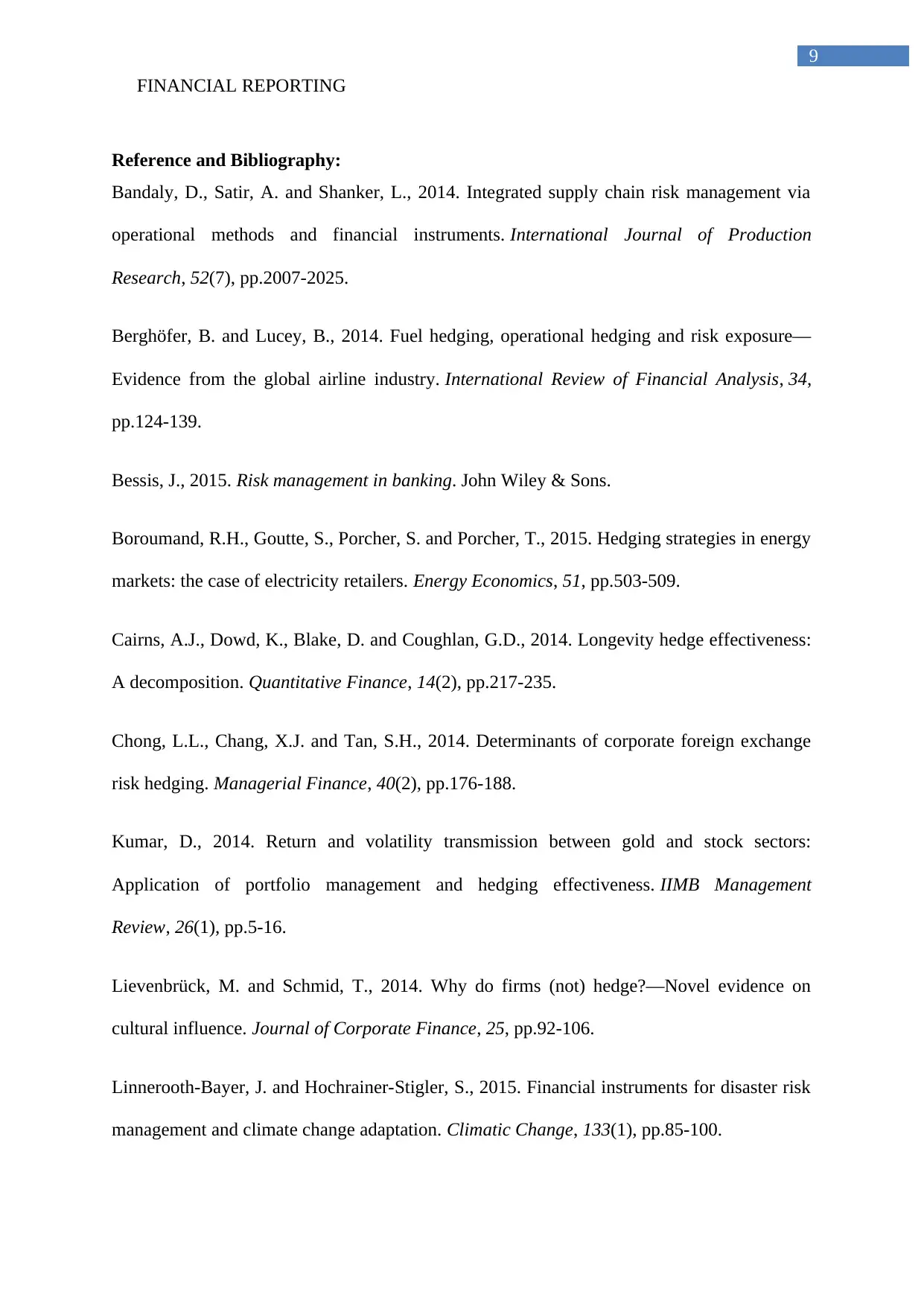
FINANCIAL REPORTING
9
Reference and Bibliography:
Bandaly, D., Satir, A. and Shanker, L., 2014. Integrated supply chain risk management via
operational methods and financial instruments. International Journal of Production
Research, 52(7), pp.2007-2025.
Berghöfer, B. and Lucey, B., 2014. Fuel hedging, operational hedging and risk exposure—
Evidence from the global airline industry. International Review of Financial Analysis, 34,
pp.124-139.
Bessis, J., 2015. Risk management in banking. John Wiley & Sons.
Boroumand, R.H., Goutte, S., Porcher, S. and Porcher, T., 2015. Hedging strategies in energy
markets: the case of electricity retailers. Energy Economics, 51, pp.503-509.
Cairns, A.J., Dowd, K., Blake, D. and Coughlan, G.D., 2014. Longevity hedge effectiveness:
A decomposition. Quantitative Finance, 14(2), pp.217-235.
Chong, L.L., Chang, X.J. and Tan, S.H., 2014. Determinants of corporate foreign exchange
risk hedging. Managerial Finance, 40(2), pp.176-188.
Kumar, D., 2014. Return and volatility transmission between gold and stock sectors:
Application of portfolio management and hedging effectiveness. IIMB Management
Review, 26(1), pp.5-16.
Lievenbrück, M. and Schmid, T., 2014. Why do firms (not) hedge?—Novel evidence on
cultural influence. Journal of Corporate Finance, 25, pp.92-106.
Linnerooth-Bayer, J. and Hochrainer-Stigler, S., 2015. Financial instruments for disaster risk
management and climate change adaptation. Climatic Change, 133(1), pp.85-100.
9
Reference and Bibliography:
Bandaly, D., Satir, A. and Shanker, L., 2014. Integrated supply chain risk management via
operational methods and financial instruments. International Journal of Production
Research, 52(7), pp.2007-2025.
Berghöfer, B. and Lucey, B., 2014. Fuel hedging, operational hedging and risk exposure—
Evidence from the global airline industry. International Review of Financial Analysis, 34,
pp.124-139.
Bessis, J., 2015. Risk management in banking. John Wiley & Sons.
Boroumand, R.H., Goutte, S., Porcher, S. and Porcher, T., 2015. Hedging strategies in energy
markets: the case of electricity retailers. Energy Economics, 51, pp.503-509.
Cairns, A.J., Dowd, K., Blake, D. and Coughlan, G.D., 2014. Longevity hedge effectiveness:
A decomposition. Quantitative Finance, 14(2), pp.217-235.
Chong, L.L., Chang, X.J. and Tan, S.H., 2014. Determinants of corporate foreign exchange
risk hedging. Managerial Finance, 40(2), pp.176-188.
Kumar, D., 2014. Return and volatility transmission between gold and stock sectors:
Application of portfolio management and hedging effectiveness. IIMB Management
Review, 26(1), pp.5-16.
Lievenbrück, M. and Schmid, T., 2014. Why do firms (not) hedge?—Novel evidence on
cultural influence. Journal of Corporate Finance, 25, pp.92-106.
Linnerooth-Bayer, J. and Hochrainer-Stigler, S., 2015. Financial instruments for disaster risk
management and climate change adaptation. Climatic Change, 133(1), pp.85-100.
Paraphrase This Document
Need a fresh take? Get an instant paraphrase of this document with our AI Paraphraser
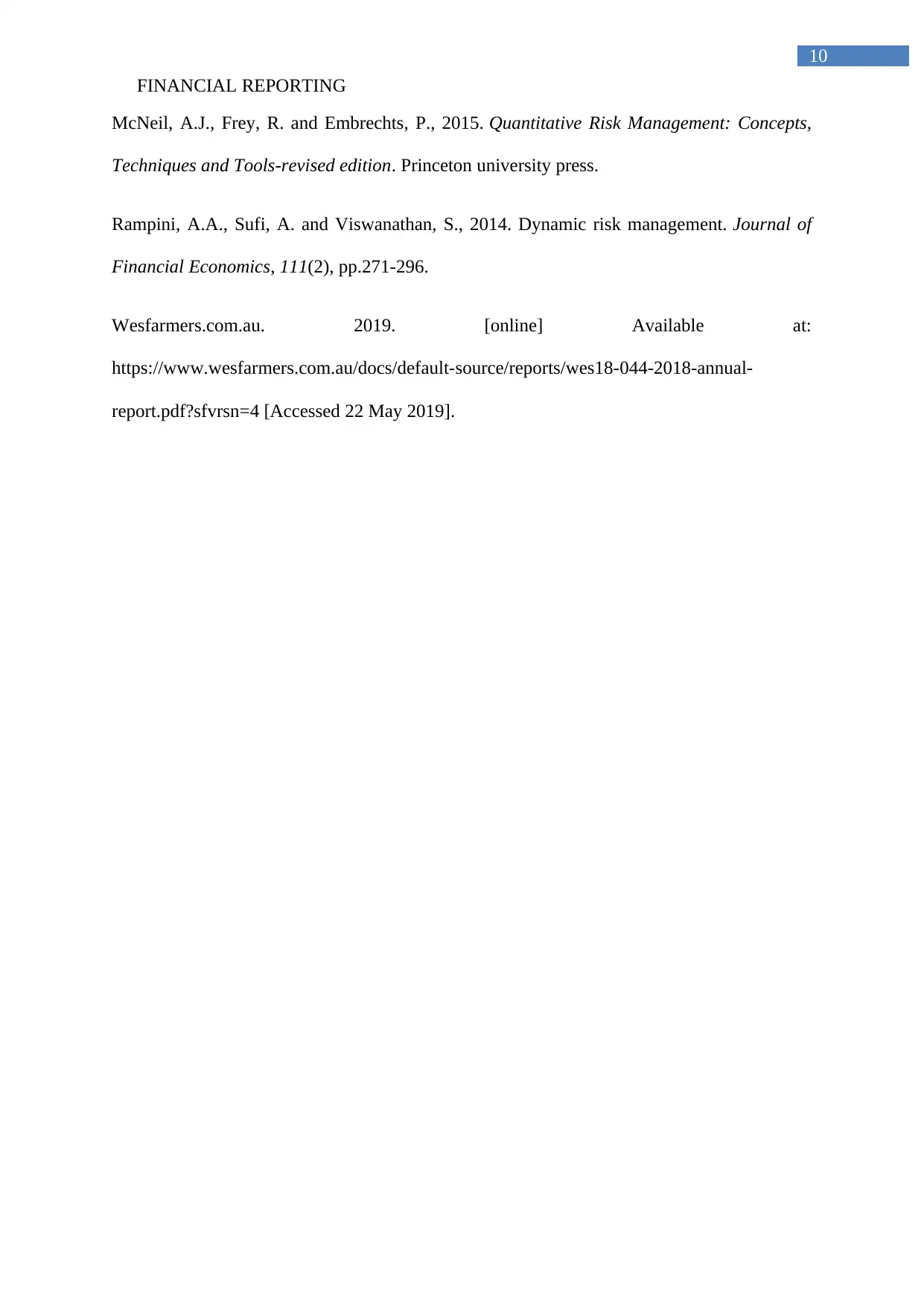
FINANCIAL REPORTING
10
McNeil, A.J., Frey, R. and Embrechts, P., 2015. Quantitative Risk Management: Concepts,
Techniques and Tools-revised edition. Princeton university press.
Rampini, A.A., Sufi, A. and Viswanathan, S., 2014. Dynamic risk management. Journal of
Financial Economics, 111(2), pp.271-296.
Wesfarmers.com.au. 2019. [online] Available at:
https://www.wesfarmers.com.au/docs/default-source/reports/wes18-044-2018-annual-
report.pdf?sfvrsn=4 [Accessed 22 May 2019].
10
McNeil, A.J., Frey, R. and Embrechts, P., 2015. Quantitative Risk Management: Concepts,
Techniques and Tools-revised edition. Princeton university press.
Rampini, A.A., Sufi, A. and Viswanathan, S., 2014. Dynamic risk management. Journal of
Financial Economics, 111(2), pp.271-296.
Wesfarmers.com.au. 2019. [online] Available at:
https://www.wesfarmers.com.au/docs/default-source/reports/wes18-044-2018-annual-
report.pdf?sfvrsn=4 [Accessed 22 May 2019].
1 out of 11
Related Documents
Your All-in-One AI-Powered Toolkit for Academic Success.
+13062052269
info@desklib.com
Available 24*7 on WhatsApp / Email
![[object Object]](/_next/static/media/star-bottom.7253800d.svg)
Unlock your academic potential
Copyright © 2020–2025 A2Z Services. All Rights Reserved. Developed and managed by ZUCOL.





